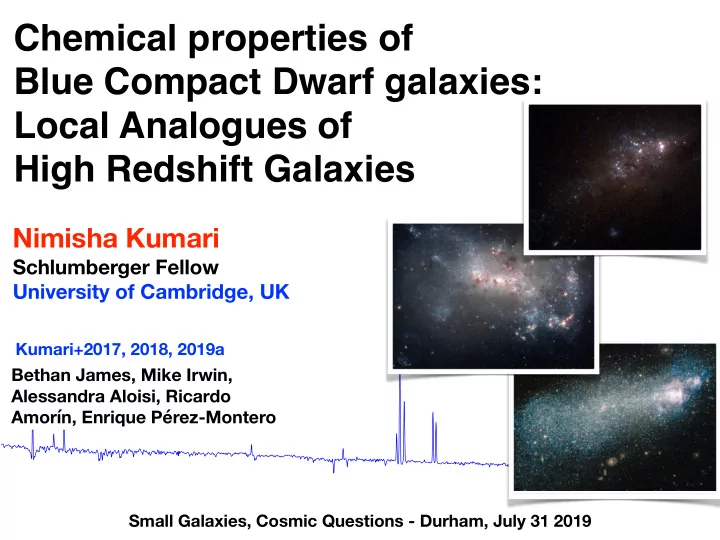

Chemical properties of Blue Compact Dwarf galaxies: Local Analogues of High Redshift Galaxies Nimisha Kumari Schlumberger Fellow University of Cambridge, UK Kumari+2017, 2018, 2019a Bethan James, Mike Irwin, Alessandra Aloisi, Ricardo Amorín, Enrique Pérez-Montero Small Galaxies, Cosmic Questions - Durham, July 31 2019 EWASS - Liverpool April 6, 2018
Why BCDs? } Local Analogs of Nearby Universe high redshift High Star Formation Rate galaxies Low Metallicity Various Studies for Various properties 1. chemical enrichment (e.g. Lanfranchi & Matteucci 2003) 2. star-formation history (e.g. McQuinn 2010) 3. dust properties (e.g. Hunt 2005) 4. WR features (e.g. James 2010) 5. stellar nucleosynthesis (e.g. Izotov & Thuan 1999) 6. black holes (e.g. Izotov 2007) 7. Pop III stars (e.g. Thuan & Izotov 2005) … and many more across EM spectrum!! Nimisha Kumari , Cambridge
Gemini Observatory - Hawaii GMOS-IFU One-slit mode: FOV: 3.5” x 5” 500 lenslets(object) 250 lenslets(sky) 0.4-1.1 μ m GMOS-Hawaii ~1000 spectra !! Two-slit mode available too !! Nimisha Kumari , Cambridge
Nimisha Kumari Cambridge Primary Sample of BCDs NGC 4670 F660N NGC 4449 F606W F439W SBS 1415
Research goals: Galaxy formation & Evolution chemical abundance—star-formation—gas dynamics Questions • Do chemical inhomogeneities exist at parsec scale in BCDs? Bathtub • What are the possible ionisation Model Lilly 2013 mechanisms at play in the gas surrounding the star-forming regions in BCDs? • What are the stellar properties (e.g. age, star-formation rate) of More profound questions the stellar population currently for each BCD ionising the gas in BCDs? Nimisha Kumari , Cambridge
#1: O/H-N/O: the curious case of NGC 4670 NGC 4670 GMOS-N IFU F439W Kumari et al. 2018, MNRAS, 476, 3793 Nimisha Kumari , Cambridge
Abundance Estimates [OIII] 4363 -> abundances from robust direct Te-method Not spatially-resolved !! Nimisha Kumari , Cambridge
Abundance Estimates HII-Chi-mistry Maps (Perez-Montero 2009) Integrated spectra Direct Method Nimisha Kumari , Cambridge
An unusual negative relation within NGC 4670 What is expected? 20 starburst galaxies (Lopez-Sanchez 2010) Nimisha Kumari , Cambridge
HII regions within 10 BCDs low- & intermediate Z high Z low Z Negative slope agrees with Kobulnicky+1996
How to explain the negative trend? Alternative/ Complementary (Amorin 2010) hypotheses: Nitrogen enrichment/ pollution, Star-formation e ffi ciency, simultaneous inflow & outflow, Supernovae triggering winds Kumari et al. 2018, MNRAS, 476, 3793 Nimisha Kumari , Cambridge
#2: NGC 4449: inverse metallicity gradient Kumari et al. 2017, NGC 4449 MNRAS, 470, 4618 GMOS-N IFU Central Star- forming region F660N Nimisha Kumari , Cambridge
[OIII] 4363 -> metallicity from robust direct Te-method Nimisha Kumari , Cambridge
Similar observations at low and high-z in Cresci+2010, Werk2010, Elmegreen+2012, Sanchez-Almedia+2014,2015 Alternative/ Complementary hypotheses: Inflow of Metal- poor gas, Outflow of metal- rich gas, Supernovae winds, Merger events Kumari et al. 2017, MNRAS, 470, 4618 Metal-poor Star-forming region: Accretion of metal-poor gas Nimisha Kumari , Cambridge
#3:SBS 1415+437: integrated vs spatially-resolved abundances SBS 1415+437 Kumari+2019, MNRAS, 485, 1103 Reg1 GMOS-N IFU Nimisha Kumari , F606W Cambridge
[OIII] 4363 spatially-resolved -> Metallicity map from the robust direct Te-method Nimisha Kumari , Cambridge
Segmentation Analysis H 𝛃 Agreement b/w spatially-resolved and integrated abundances => confidence to high-z abundance measurements (e.g. JWST) Nimisha Kumari , Cambridge
What Next: Keck Cosmic Web Imager MUSE on VLT FoV: 20” x 33” FoV: 1’x1’ MANGA-SDSS WEAVE (WHT) FoV: 1’ x 1’ ALMA JWST
Summary • NGC 4670: negative N/O vs O/H relation (Kumari+2018, MNRAS,476,3793) => may be a negative N/O vs O/H exists within other galaxies • NGC 4449: inverse metallicity gradient (Kumari+2017, MNRAS, 470, 4618) => accretion of metal-poor gas to the centre • SBS 1415+437: spatially-resolved abundance agrees with integrated abundance (Kumari+2019, MNRAS, 485, 1103) => confidence to high-z results (e.g. JWST) • Analysis of entire BCDs with IFU data => Useful for high-z studies Thanks!! Nimisha Kumari , Cambridge
Recommend
More recommend